International Business Coursework Report: J&J and Global Strategies
VerifiedAdded on 2022/11/23
|13
|4235
|473
Report
AI Summary
This report provides an in-depth analysis of Johnson & Johnson's (J&J) international business operations. It begins with a comparison of international trade and international business, followed by an overview of J&J, including its product portfolio, geographical markets, and modes of transaction. The report then applies the 'Global Integration/Local Responsiveness' framework, examining J&J's strategies of export, standardization, multidomestic, and transnational approaches. Further, the report utilizes Hofstede's cultural dimensions model to compare Germany and the United States. Finally, it discusses the progress model of internationalization and patterns of internalization. The report emphasizes the importance of understanding cultural differences and adapting business strategies to succeed in the global market.
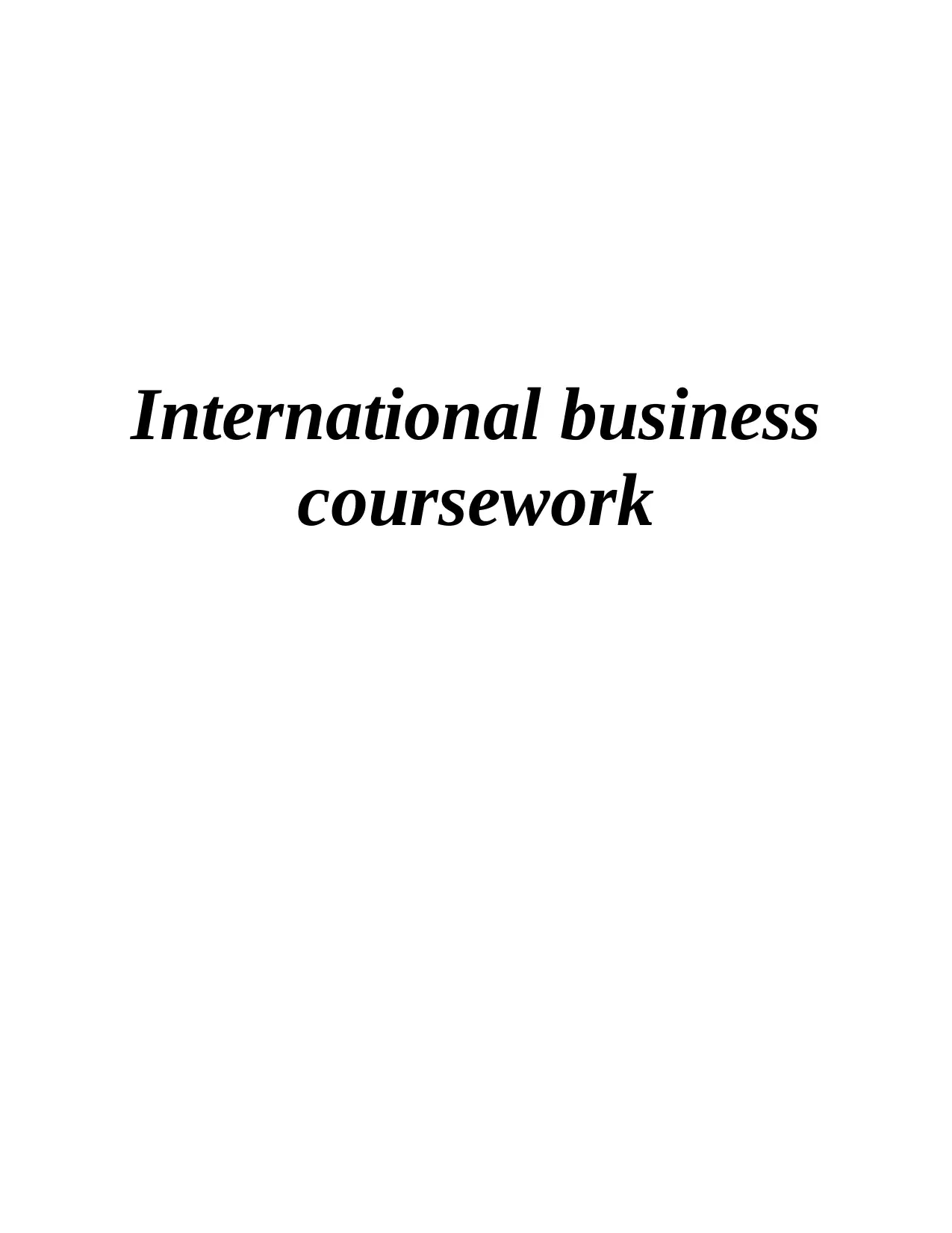
International business
coursework
coursework
Secure Best Marks with AI Grader
Need help grading? Try our AI Grader for instant feedback on your assignments.
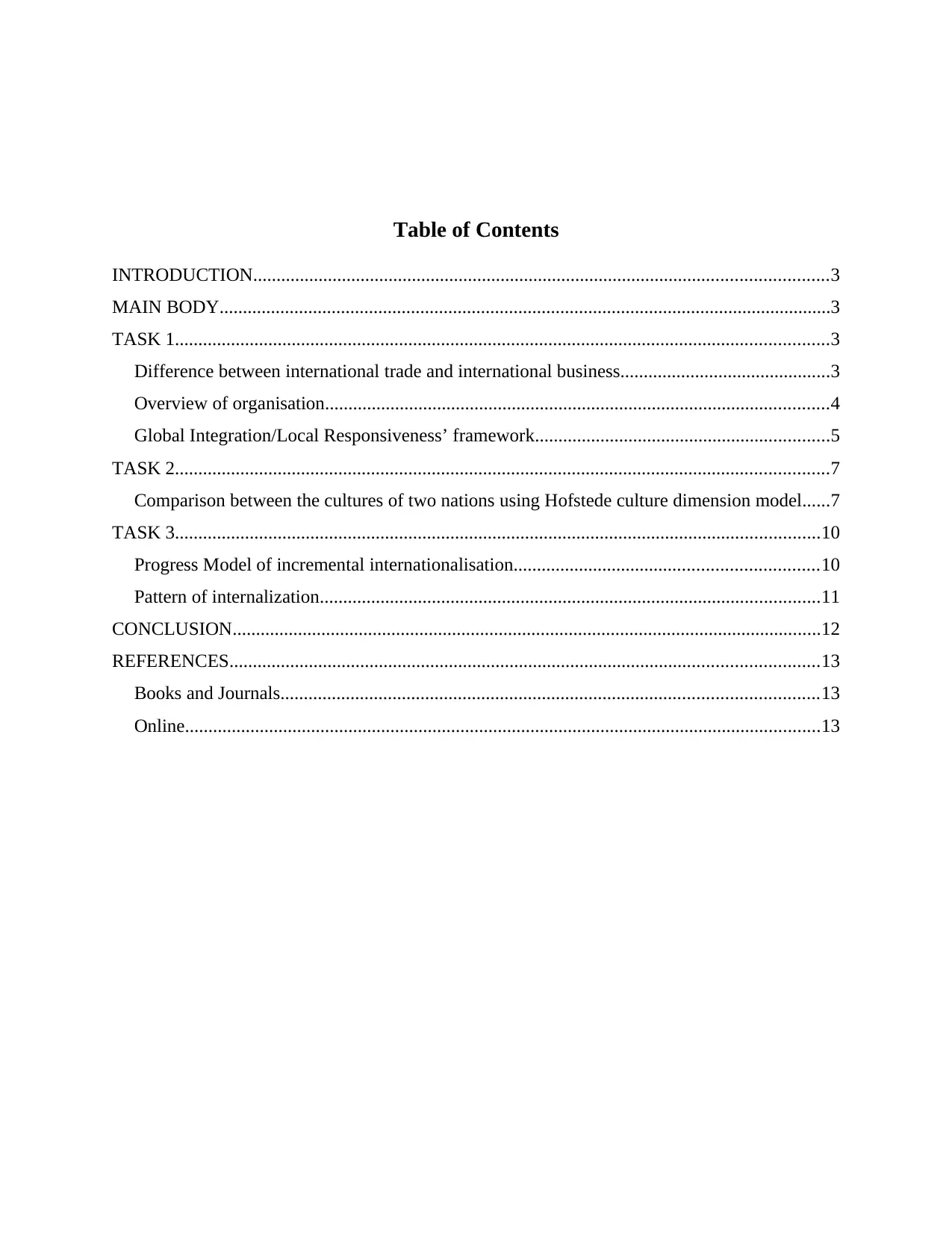
Table of Contents
INTRODUCTION...........................................................................................................................3
MAIN BODY...................................................................................................................................3
TASK 1............................................................................................................................................3
Difference between international trade and international business.............................................3
Overview of organisation............................................................................................................4
Global Integration/Local Responsiveness’ framework...............................................................5
TASK 2............................................................................................................................................7
Comparison between the cultures of two nations using Hofstede culture dimension model......7
TASK 3..........................................................................................................................................10
Progress Model of incremental internationalisation.................................................................10
Pattern of internalization...........................................................................................................11
CONCLUSION..............................................................................................................................12
REFERENCES..............................................................................................................................13
Books and Journals...................................................................................................................13
Online........................................................................................................................................13
INTRODUCTION...........................................................................................................................3
MAIN BODY...................................................................................................................................3
TASK 1............................................................................................................................................3
Difference between international trade and international business.............................................3
Overview of organisation............................................................................................................4
Global Integration/Local Responsiveness’ framework...............................................................5
TASK 2............................................................................................................................................7
Comparison between the cultures of two nations using Hofstede culture dimension model......7
TASK 3..........................................................................................................................................10
Progress Model of incremental internationalisation.................................................................10
Pattern of internalization...........................................................................................................11
CONCLUSION..............................................................................................................................12
REFERENCES..............................................................................................................................13
Books and Journals...................................................................................................................13
Online........................................................................................................................................13
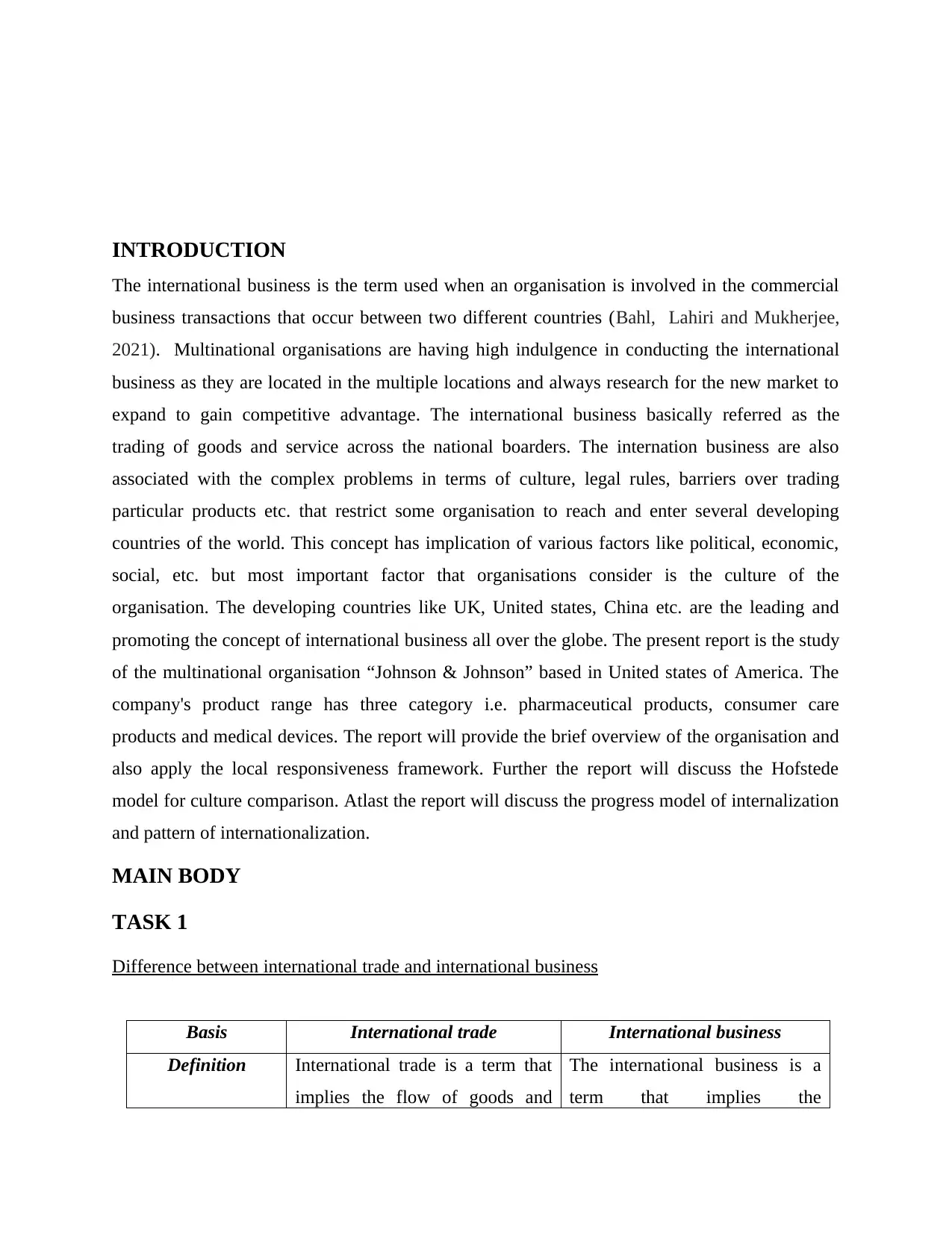
INTRODUCTION
The international business is the term used when an organisation is involved in the commercial
business transactions that occur between two different countries (Bahl, Lahiri and Mukherjee,
2021). Multinational organisations are having high indulgence in conducting the international
business as they are located in the multiple locations and always research for the new market to
expand to gain competitive advantage. The international business basically referred as the
trading of goods and service across the national boarders. The internation business are also
associated with the complex problems in terms of culture, legal rules, barriers over trading
particular products etc. that restrict some organisation to reach and enter several developing
countries of the world. This concept has implication of various factors like political, economic,
social, etc. but most important factor that organisations consider is the culture of the
organisation. The developing countries like UK, United states, China etc. are the leading and
promoting the concept of international business all over the globe. The present report is the study
of the multinational organisation “Johnson & Johnson” based in United states of America. The
company's product range has three category i.e. pharmaceutical products, consumer care
products and medical devices. The report will provide the brief overview of the organisation and
also apply the local responsiveness framework. Further the report will discuss the Hofstede
model for culture comparison. Atlast the report will discuss the progress model of internalization
and pattern of internationalization.
MAIN BODY
TASK 1
Difference between international trade and international business
Basis International trade International business
Definition International trade is a term that
implies the flow of goods and
The international business is a
term that implies the
The international business is the term used when an organisation is involved in the commercial
business transactions that occur between two different countries (Bahl, Lahiri and Mukherjee,
2021). Multinational organisations are having high indulgence in conducting the international
business as they are located in the multiple locations and always research for the new market to
expand to gain competitive advantage. The international business basically referred as the
trading of goods and service across the national boarders. The internation business are also
associated with the complex problems in terms of culture, legal rules, barriers over trading
particular products etc. that restrict some organisation to reach and enter several developing
countries of the world. This concept has implication of various factors like political, economic,
social, etc. but most important factor that organisations consider is the culture of the
organisation. The developing countries like UK, United states, China etc. are the leading and
promoting the concept of international business all over the globe. The present report is the study
of the multinational organisation “Johnson & Johnson” based in United states of America. The
company's product range has three category i.e. pharmaceutical products, consumer care
products and medical devices. The report will provide the brief overview of the organisation and
also apply the local responsiveness framework. Further the report will discuss the Hofstede
model for culture comparison. Atlast the report will discuss the progress model of internalization
and pattern of internationalization.
MAIN BODY
TASK 1
Difference between international trade and international business
Basis International trade International business
Definition International trade is a term that
implies the flow of goods and
The international business is a
term that implies the
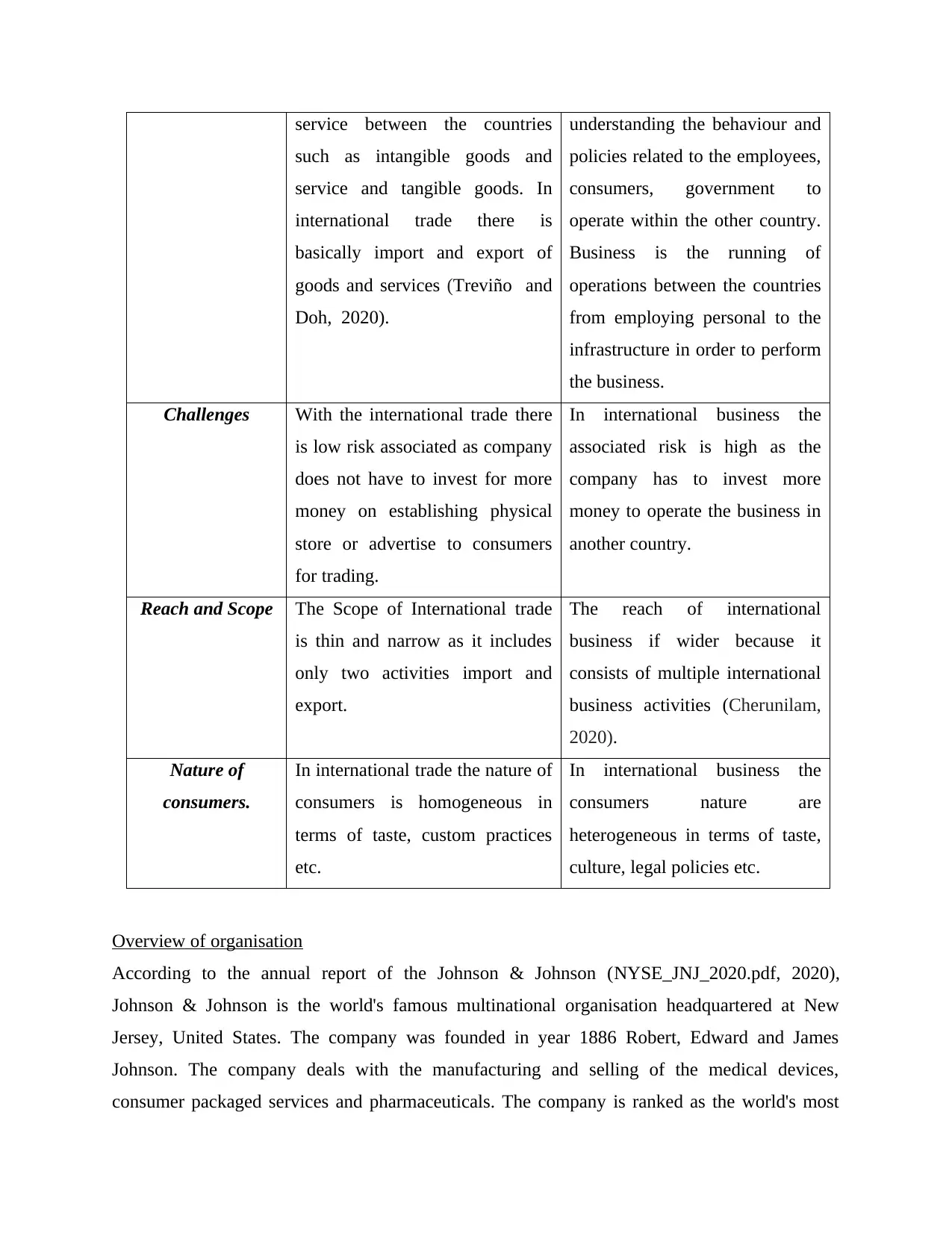
service between the countries
such as intangible goods and
service and tangible goods. In
international trade there is
basically import and export of
goods and services (Treviño and
Doh, 2020).
understanding the behaviour and
policies related to the employees,
consumers, government to
operate within the other country.
Business is the running of
operations between the countries
from employing personal to the
infrastructure in order to perform
the business.
Challenges With the international trade there
is low risk associated as company
does not have to invest for more
money on establishing physical
store or advertise to consumers
for trading.
In international business the
associated risk is high as the
company has to invest more
money to operate the business in
another country.
Reach and Scope The Scope of International trade
is thin and narrow as it includes
only two activities import and
export.
The reach of international
business if wider because it
consists of multiple international
business activities (Cherunilam,
2020).
Nature of
consumers.
In international trade the nature of
consumers is homogeneous in
terms of taste, custom practices
etc.
In international business the
consumers nature are
heterogeneous in terms of taste,
culture, legal policies etc.
Overview of organisation
According to the annual report of the Johnson & Johnson (NYSE_JNJ_2020.pdf, 2020),
Johnson & Johnson is the world's famous multinational organisation headquartered at New
Jersey, United States. The company was founded in year 1886 Robert, Edward and James
Johnson. The company deals with the manufacturing and selling of the medical devices,
consumer packaged services and pharmaceuticals. The company is ranked as the world's most
such as intangible goods and
service and tangible goods. In
international trade there is
basically import and export of
goods and services (Treviño and
Doh, 2020).
understanding the behaviour and
policies related to the employees,
consumers, government to
operate within the other country.
Business is the running of
operations between the countries
from employing personal to the
infrastructure in order to perform
the business.
Challenges With the international trade there
is low risk associated as company
does not have to invest for more
money on establishing physical
store or advertise to consumers
for trading.
In international business the
associated risk is high as the
company has to invest more
money to operate the business in
another country.
Reach and Scope The Scope of International trade
is thin and narrow as it includes
only two activities import and
export.
The reach of international
business if wider because it
consists of multiple international
business activities (Cherunilam,
2020).
Nature of
consumers.
In international trade the nature of
consumers is homogeneous in
terms of taste, custom practices
etc.
In international business the
consumers nature are
heterogeneous in terms of taste,
culture, legal policies etc.
Overview of organisation
According to the annual report of the Johnson & Johnson (NYSE_JNJ_2020.pdf, 2020),
Johnson & Johnson is the world's famous multinational organisation headquartered at New
Jersey, United States. The company was founded in year 1886 Robert, Edward and James
Johnson. The company deals with the manufacturing and selling of the medical devices,
consumer packaged services and pharmaceuticals. The company is ranked as the world's most
Secure Best Marks with AI Grader
Need help grading? Try our AI Grader for instant feedback on your assignments.
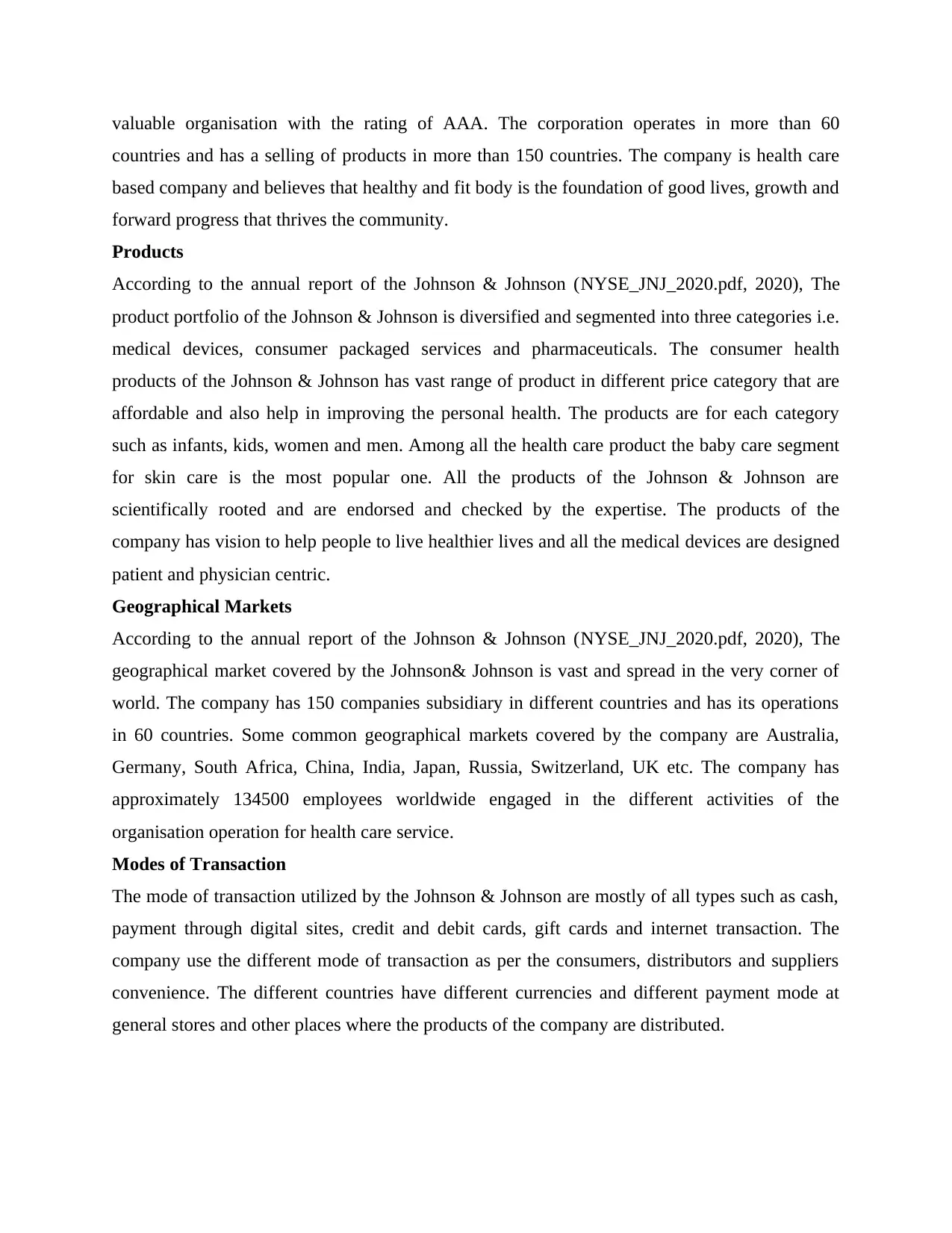
valuable organisation with the rating of AAA. The corporation operates in more than 60
countries and has a selling of products in more than 150 countries. The company is health care
based company and believes that healthy and fit body is the foundation of good lives, growth and
forward progress that thrives the community.
Products
According to the annual report of the Johnson & Johnson (NYSE_JNJ_2020.pdf, 2020), The
product portfolio of the Johnson & Johnson is diversified and segmented into three categories i.e.
medical devices, consumer packaged services and pharmaceuticals. The consumer health
products of the Johnson & Johnson has vast range of product in different price category that are
affordable and also help in improving the personal health. The products are for each category
such as infants, kids, women and men. Among all the health care product the baby care segment
for skin care is the most popular one. All the products of the Johnson & Johnson are
scientifically rooted and are endorsed and checked by the expertise. The products of the
company has vision to help people to live healthier lives and all the medical devices are designed
patient and physician centric.
Geographical Markets
According to the annual report of the Johnson & Johnson (NYSE_JNJ_2020.pdf, 2020), The
geographical market covered by the Johnson& Johnson is vast and spread in the very corner of
world. The company has 150 companies subsidiary in different countries and has its operations
in 60 countries. Some common geographical markets covered by the company are Australia,
Germany, South Africa, China, India, Japan, Russia, Switzerland, UK etc. The company has
approximately 134500 employees worldwide engaged in the different activities of the
organisation operation for health care service.
Modes of Transaction
The mode of transaction utilized by the Johnson & Johnson are mostly of all types such as cash,
payment through digital sites, credit and debit cards, gift cards and internet transaction. The
company use the different mode of transaction as per the consumers, distributors and suppliers
convenience. The different countries have different currencies and different payment mode at
general stores and other places where the products of the company are distributed.
countries and has a selling of products in more than 150 countries. The company is health care
based company and believes that healthy and fit body is the foundation of good lives, growth and
forward progress that thrives the community.
Products
According to the annual report of the Johnson & Johnson (NYSE_JNJ_2020.pdf, 2020), The
product portfolio of the Johnson & Johnson is diversified and segmented into three categories i.e.
medical devices, consumer packaged services and pharmaceuticals. The consumer health
products of the Johnson & Johnson has vast range of product in different price category that are
affordable and also help in improving the personal health. The products are for each category
such as infants, kids, women and men. Among all the health care product the baby care segment
for skin care is the most popular one. All the products of the Johnson & Johnson are
scientifically rooted and are endorsed and checked by the expertise. The products of the
company has vision to help people to live healthier lives and all the medical devices are designed
patient and physician centric.
Geographical Markets
According to the annual report of the Johnson & Johnson (NYSE_JNJ_2020.pdf, 2020), The
geographical market covered by the Johnson& Johnson is vast and spread in the very corner of
world. The company has 150 companies subsidiary in different countries and has its operations
in 60 countries. Some common geographical markets covered by the company are Australia,
Germany, South Africa, China, India, Japan, Russia, Switzerland, UK etc. The company has
approximately 134500 employees worldwide engaged in the different activities of the
organisation operation for health care service.
Modes of Transaction
The mode of transaction utilized by the Johnson & Johnson are mostly of all types such as cash,
payment through digital sites, credit and debit cards, gift cards and internet transaction. The
company use the different mode of transaction as per the consumers, distributors and suppliers
convenience. The different countries have different currencies and different payment mode at
general stores and other places where the products of the company are distributed.
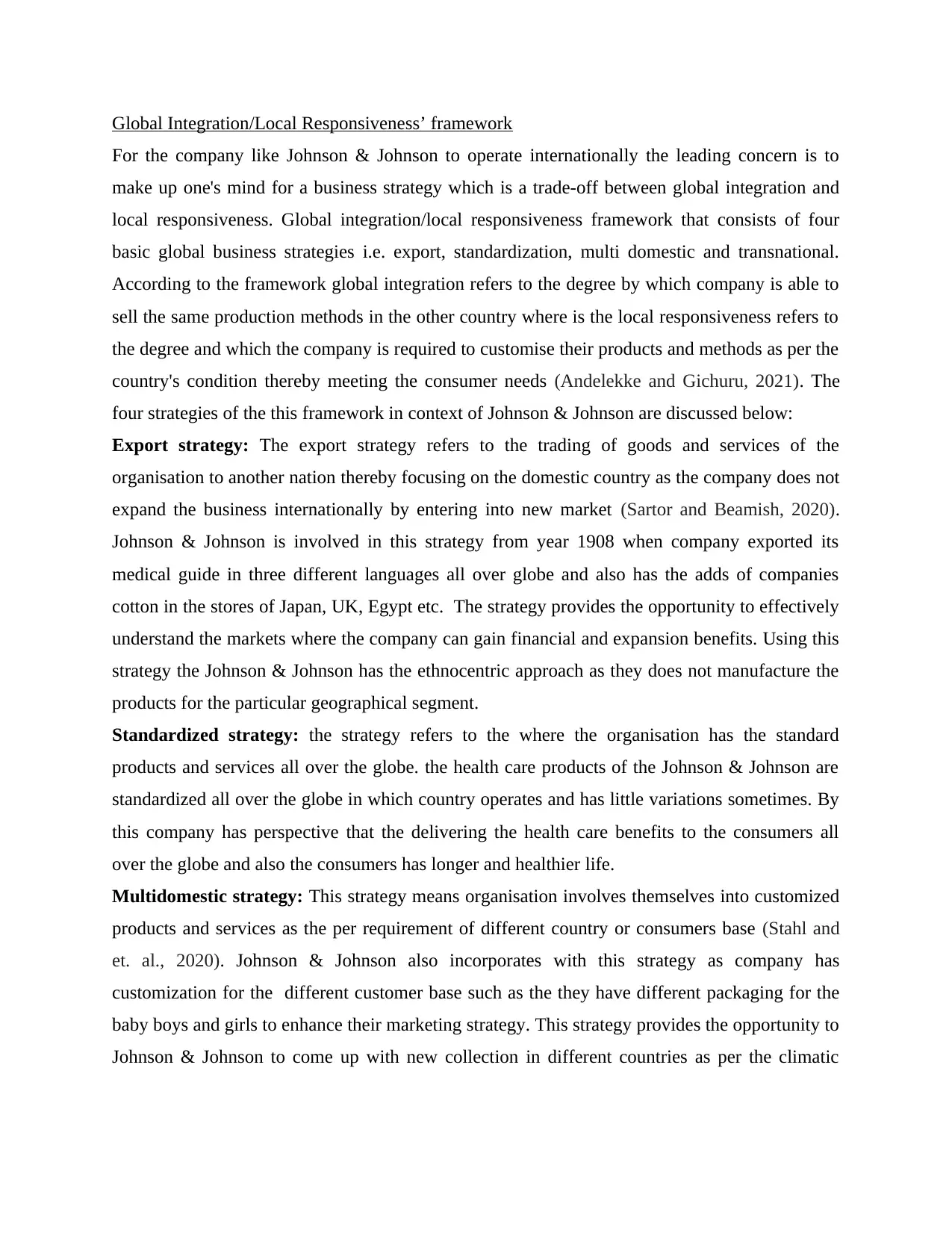
Global Integration/Local Responsiveness’ framework
For the company like Johnson & Johnson to operate internationally the leading concern is to
make up one's mind for a business strategy which is a trade-off between global integration and
local responsiveness. Global integration/local responsiveness framework that consists of four
basic global business strategies i.e. export, standardization, multi domestic and transnational.
According to the framework global integration refers to the degree by which company is able to
sell the same production methods in the other country where is the local responsiveness refers to
the degree and which the company is required to customise their products and methods as per the
country's condition thereby meeting the consumer needs (Andelekke and Gichuru, 2021). The
four strategies of the this framework in context of Johnson & Johnson are discussed below:
Export strategy: The export strategy refers to the trading of goods and services of the
organisation to another nation thereby focusing on the domestic country as the company does not
expand the business internationally by entering into new market (Sartor and Beamish, 2020).
Johnson & Johnson is involved in this strategy from year 1908 when company exported its
medical guide in three different languages all over globe and also has the adds of companies
cotton in the stores of Japan, UK, Egypt etc. The strategy provides the opportunity to effectively
understand the markets where the company can gain financial and expansion benefits. Using this
strategy the Johnson & Johnson has the ethnocentric approach as they does not manufacture the
products for the particular geographical segment.
Standardized strategy: the strategy refers to the where the organisation has the standard
products and services all over the globe. the health care products of the Johnson & Johnson are
standardized all over the globe in which country operates and has little variations sometimes. By
this company has perspective that the delivering the health care benefits to the consumers all
over the globe and also the consumers has longer and healthier life.
Multidomestic strategy: This strategy means organisation involves themselves into customized
products and services as the per requirement of different country or consumers base (Stahl and
et. al., 2020). Johnson & Johnson also incorporates with this strategy as company has
customization for the different customer base such as the they have different packaging for the
baby boys and girls to enhance their marketing strategy. This strategy provides the opportunity to
Johnson & Johnson to come up with new collection in different countries as per the climatic
For the company like Johnson & Johnson to operate internationally the leading concern is to
make up one's mind for a business strategy which is a trade-off between global integration and
local responsiveness. Global integration/local responsiveness framework that consists of four
basic global business strategies i.e. export, standardization, multi domestic and transnational.
According to the framework global integration refers to the degree by which company is able to
sell the same production methods in the other country where is the local responsiveness refers to
the degree and which the company is required to customise their products and methods as per the
country's condition thereby meeting the consumer needs (Andelekke and Gichuru, 2021). The
four strategies of the this framework in context of Johnson & Johnson are discussed below:
Export strategy: The export strategy refers to the trading of goods and services of the
organisation to another nation thereby focusing on the domestic country as the company does not
expand the business internationally by entering into new market (Sartor and Beamish, 2020).
Johnson & Johnson is involved in this strategy from year 1908 when company exported its
medical guide in three different languages all over globe and also has the adds of companies
cotton in the stores of Japan, UK, Egypt etc. The strategy provides the opportunity to effectively
understand the markets where the company can gain financial and expansion benefits. Using this
strategy the Johnson & Johnson has the ethnocentric approach as they does not manufacture the
products for the particular geographical segment.
Standardized strategy: the strategy refers to the where the organisation has the standard
products and services all over the globe. the health care products of the Johnson & Johnson are
standardized all over the globe in which country operates and has little variations sometimes. By
this company has perspective that the delivering the health care benefits to the consumers all
over the globe and also the consumers has longer and healthier life.
Multidomestic strategy: This strategy means organisation involves themselves into customized
products and services as the per requirement of different country or consumers base (Stahl and
et. al., 2020). Johnson & Johnson also incorporates with this strategy as company has
customization for the different customer base such as the they have different packaging for the
baby boys and girls to enhance their marketing strategy. This strategy provides the opportunity to
Johnson & Johnson to come up with new collection in different countries as per the climatic

conditions which gains the attention of consumers and supports the company to raise their
profits.
Transnational strategy: This strategy is the combination of the standardized and multi domestic
strategy. The strategy is utilized by the multinational organisation when they receives the
pressure of reducing cost in foreign market but also sell the products that meet customers needs
in that particular market. Johnson & Johnson does not comply with any of such strategy as the
prices of products are similar all across the globe and also are affordable and also company
always adopt the methods that can reduce the prices more for the medicals devices.
TASK 2
Comparison between the cultures of two nations using Hofstede culture dimension model
Basis Germany United states
Power distance
index
The power distance index refers to the extent to which employees and members
of an organisation accepts and expect the distribution of unequal power.
In Germany the score of power
distance index is 35 which means the
lower score of PDI therefore there is
decentralized and there are co
determination rights. The society
highly supports the participative
communication and also there is no
control (Doetzer, 2020).
The score for the Power distance
index is 40 which means the unites
states believes that inequality of power
between the employees and
subordinates should be declined. But
there is the culture of unequal power
distribution.
Individualism
and
collectivism
The individualism refers to the employees of an organisation that pay more
attention to attain its self goals whereas the collectivism refers to the
organisation where the team work is supported and greater emphasises is given
to group goals.
In Germany the score of this
dimension is 67 and higher score
The score for this dimension is 91
which is extremely higher
profits.
Transnational strategy: This strategy is the combination of the standardized and multi domestic
strategy. The strategy is utilized by the multinational organisation when they receives the
pressure of reducing cost in foreign market but also sell the products that meet customers needs
in that particular market. Johnson & Johnson does not comply with any of such strategy as the
prices of products are similar all across the globe and also are affordable and also company
always adopt the methods that can reduce the prices more for the medicals devices.
TASK 2
Comparison between the cultures of two nations using Hofstede culture dimension model
Basis Germany United states
Power distance
index
The power distance index refers to the extent to which employees and members
of an organisation accepts and expect the distribution of unequal power.
In Germany the score of power
distance index is 35 which means the
lower score of PDI therefore there is
decentralized and there are co
determination rights. The society
highly supports the participative
communication and also there is no
control (Doetzer, 2020).
The score for the Power distance
index is 40 which means the unites
states believes that inequality of power
between the employees and
subordinates should be declined. But
there is the culture of unequal power
distribution.
Individualism
and
collectivism
The individualism refers to the employees of an organisation that pay more
attention to attain its self goals whereas the collectivism refers to the
organisation where the team work is supported and greater emphasises is given
to group goals.
In Germany the score of this
dimension is 67 and higher score
The score for this dimension is 91
which is extremely higher
Paraphrase This Document
Need a fresh take? Get an instant paraphrase of this document with our AI Paraphraser
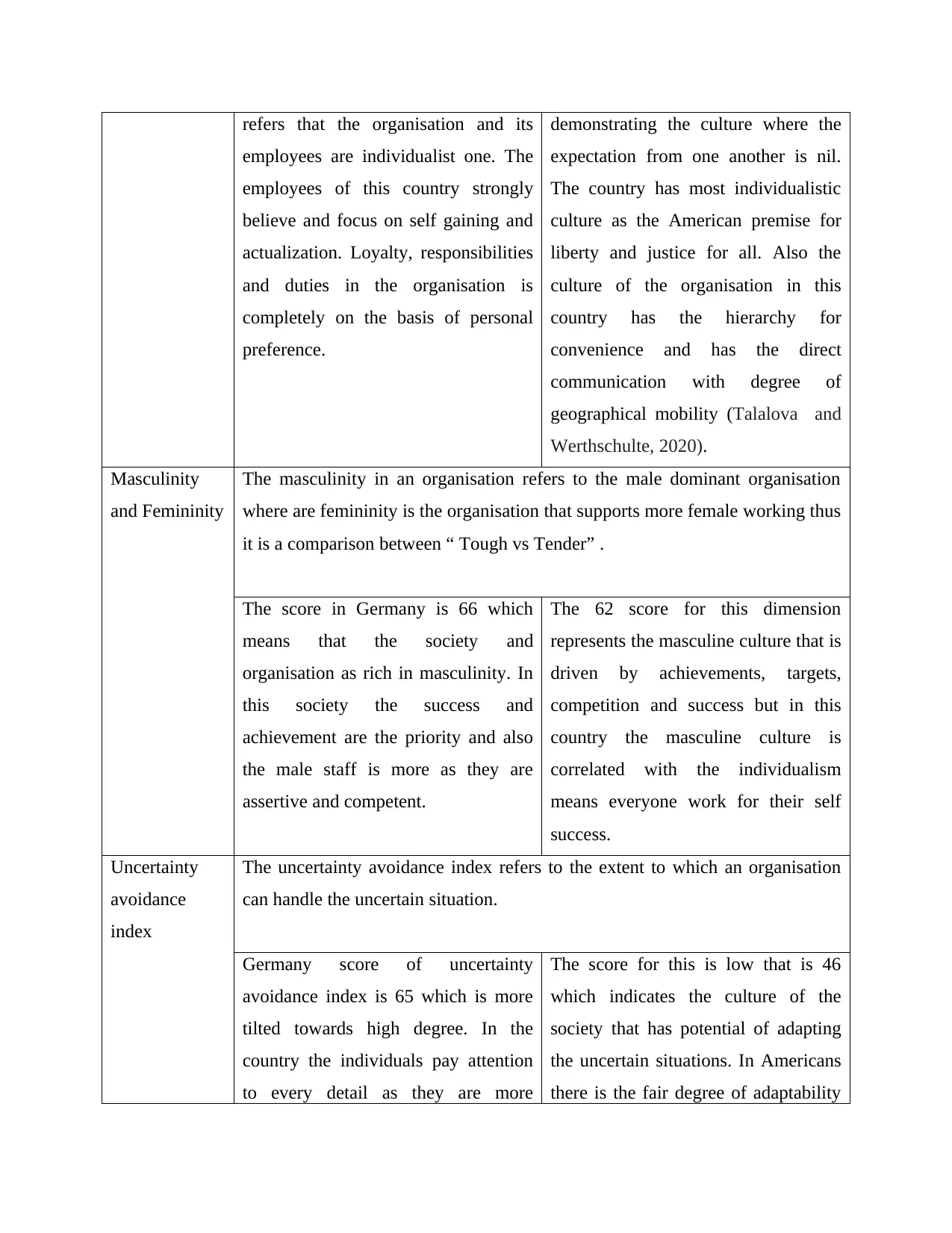
refers that the organisation and its
employees are individualist one. The
employees of this country strongly
believe and focus on self gaining and
actualization. Loyalty, responsibilities
and duties in the organisation is
completely on the basis of personal
preference.
demonstrating the culture where the
expectation from one another is nil.
The country has most individualistic
culture as the American premise for
liberty and justice for all. Also the
culture of the organisation in this
country has the hierarchy for
convenience and has the direct
communication with degree of
geographical mobility (Talalova and
Werthschulte, 2020).
Masculinity
and Femininity
The masculinity in an organisation refers to the male dominant organisation
where are femininity is the organisation that supports more female working thus
it is a comparison between “ Tough vs Tender” .
The score in Germany is 66 which
means that the society and
organisation as rich in masculinity. In
this society the success and
achievement are the priority and also
the male staff is more as they are
assertive and competent.
The 62 score for this dimension
represents the masculine culture that is
driven by achievements, targets,
competition and success but in this
country the masculine culture is
correlated with the individualism
means everyone work for their self
success.
Uncertainty
avoidance
index
The uncertainty avoidance index refers to the extent to which an organisation
can handle the uncertain situation.
Germany score of uncertainty
avoidance index is 65 which is more
tilted towards high degree. In the
country the individuals pay attention
to every detail as they are more
The score for this is low that is 46
which indicates the culture of the
society that has potential of adapting
the uncertain situations. In Americans
there is the fair degree of adaptability
employees are individualist one. The
employees of this country strongly
believe and focus on self gaining and
actualization. Loyalty, responsibilities
and duties in the organisation is
completely on the basis of personal
preference.
demonstrating the culture where the
expectation from one another is nil.
The country has most individualistic
culture as the American premise for
liberty and justice for all. Also the
culture of the organisation in this
country has the hierarchy for
convenience and has the direct
communication with degree of
geographical mobility (Talalova and
Werthschulte, 2020).
Masculinity
and Femininity
The masculinity in an organisation refers to the male dominant organisation
where are femininity is the organisation that supports more female working thus
it is a comparison between “ Tough vs Tender” .
The score in Germany is 66 which
means that the society and
organisation as rich in masculinity. In
this society the success and
achievement are the priority and also
the male staff is more as they are
assertive and competent.
The 62 score for this dimension
represents the masculine culture that is
driven by achievements, targets,
competition and success but in this
country the masculine culture is
correlated with the individualism
means everyone work for their self
success.
Uncertainty
avoidance
index
The uncertainty avoidance index refers to the extent to which an organisation
can handle the uncertain situation.
Germany score of uncertainty
avoidance index is 65 which is more
tilted towards high degree. In the
country the individuals pay attention
to every detail as they are more
The score for this is low that is 46
which indicates the culture of the
society that has potential of adapting
the uncertain situations. In Americans
there is the fair degree of adaptability
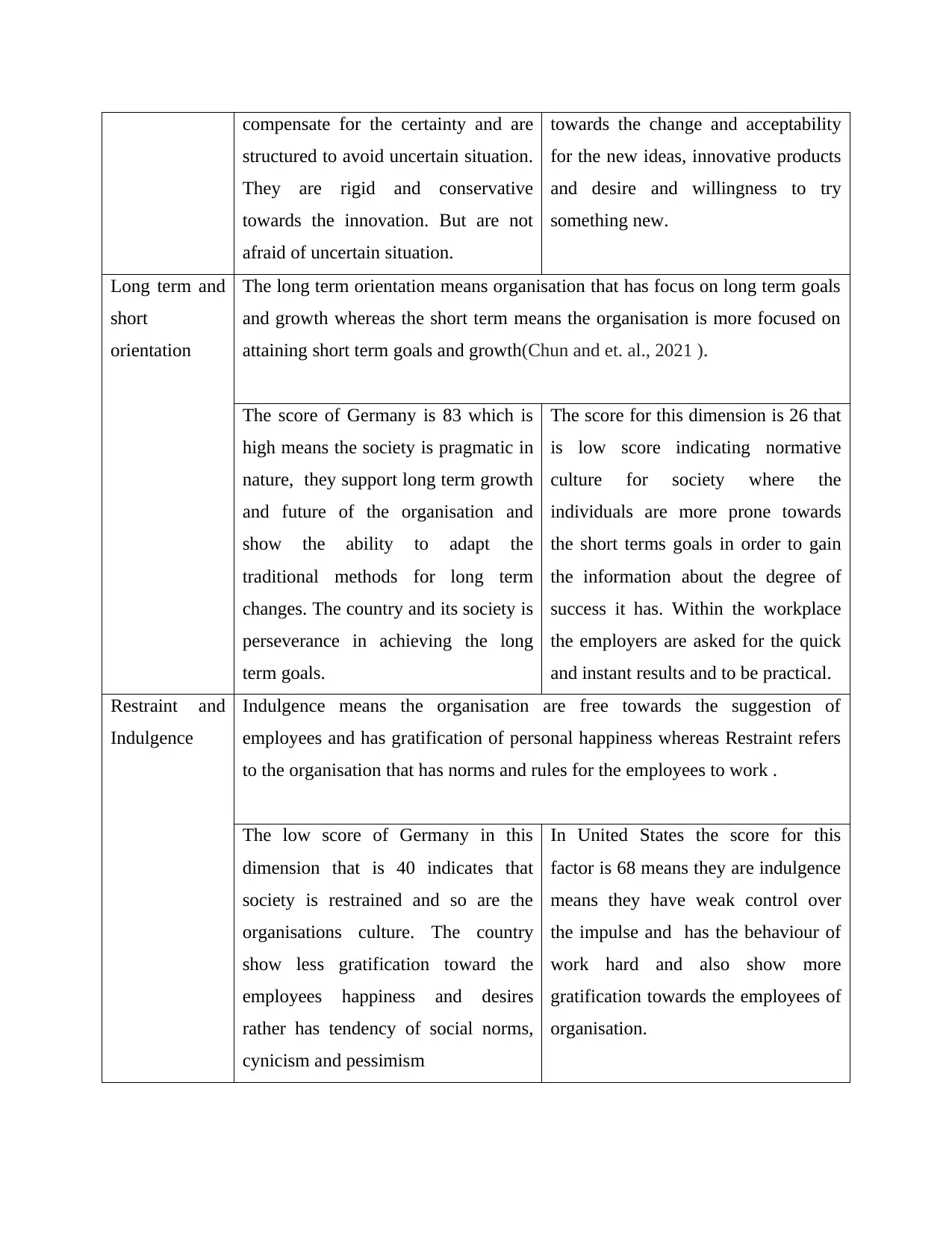
compensate for the certainty and are
structured to avoid uncertain situation.
They are rigid and conservative
towards the innovation. But are not
afraid of uncertain situation.
towards the change and acceptability
for the new ideas, innovative products
and desire and willingness to try
something new.
Long term and
short
orientation
The long term orientation means organisation that has focus on long term goals
and growth whereas the short term means the organisation is more focused on
attaining short term goals and growth(Chun and et. al., 2021 ).
The score of Germany is 83 which is
high means the society is pragmatic in
nature, they support long term growth
and future of the organisation and
show the ability to adapt the
traditional methods for long term
changes. The country and its society is
perseverance in achieving the long
term goals.
The score for this dimension is 26 that
is low score indicating normative
culture for society where the
individuals are more prone towards
the short terms goals in order to gain
the information about the degree of
success it has. Within the workplace
the employers are asked for the quick
and instant results and to be practical.
Restraint and
Indulgence
Indulgence means the organisation are free towards the suggestion of
employees and has gratification of personal happiness whereas Restraint refers
to the organisation that has norms and rules for the employees to work .
The low score of Germany in this
dimension that is 40 indicates that
society is restrained and so are the
organisations culture. The country
show less gratification toward the
employees happiness and desires
rather has tendency of social norms,
cynicism and pessimism
In United States the score for this
factor is 68 means they are indulgence
means they have weak control over
the impulse and has the behaviour of
work hard and also show more
gratification towards the employees of
organisation.
structured to avoid uncertain situation.
They are rigid and conservative
towards the innovation. But are not
afraid of uncertain situation.
towards the change and acceptability
for the new ideas, innovative products
and desire and willingness to try
something new.
Long term and
short
orientation
The long term orientation means organisation that has focus on long term goals
and growth whereas the short term means the organisation is more focused on
attaining short term goals and growth(Chun and et. al., 2021 ).
The score of Germany is 83 which is
high means the society is pragmatic in
nature, they support long term growth
and future of the organisation and
show the ability to adapt the
traditional methods for long term
changes. The country and its society is
perseverance in achieving the long
term goals.
The score for this dimension is 26 that
is low score indicating normative
culture for society where the
individuals are more prone towards
the short terms goals in order to gain
the information about the degree of
success it has. Within the workplace
the employers are asked for the quick
and instant results and to be practical.
Restraint and
Indulgence
Indulgence means the organisation are free towards the suggestion of
employees and has gratification of personal happiness whereas Restraint refers
to the organisation that has norms and rules for the employees to work .
The low score of Germany in this
dimension that is 40 indicates that
society is restrained and so are the
organisations culture. The country
show less gratification toward the
employees happiness and desires
rather has tendency of social norms,
cynicism and pessimism
In United States the score for this
factor is 68 means they are indulgence
means they have weak control over
the impulse and has the behaviour of
work hard and also show more
gratification towards the employees of
organisation.
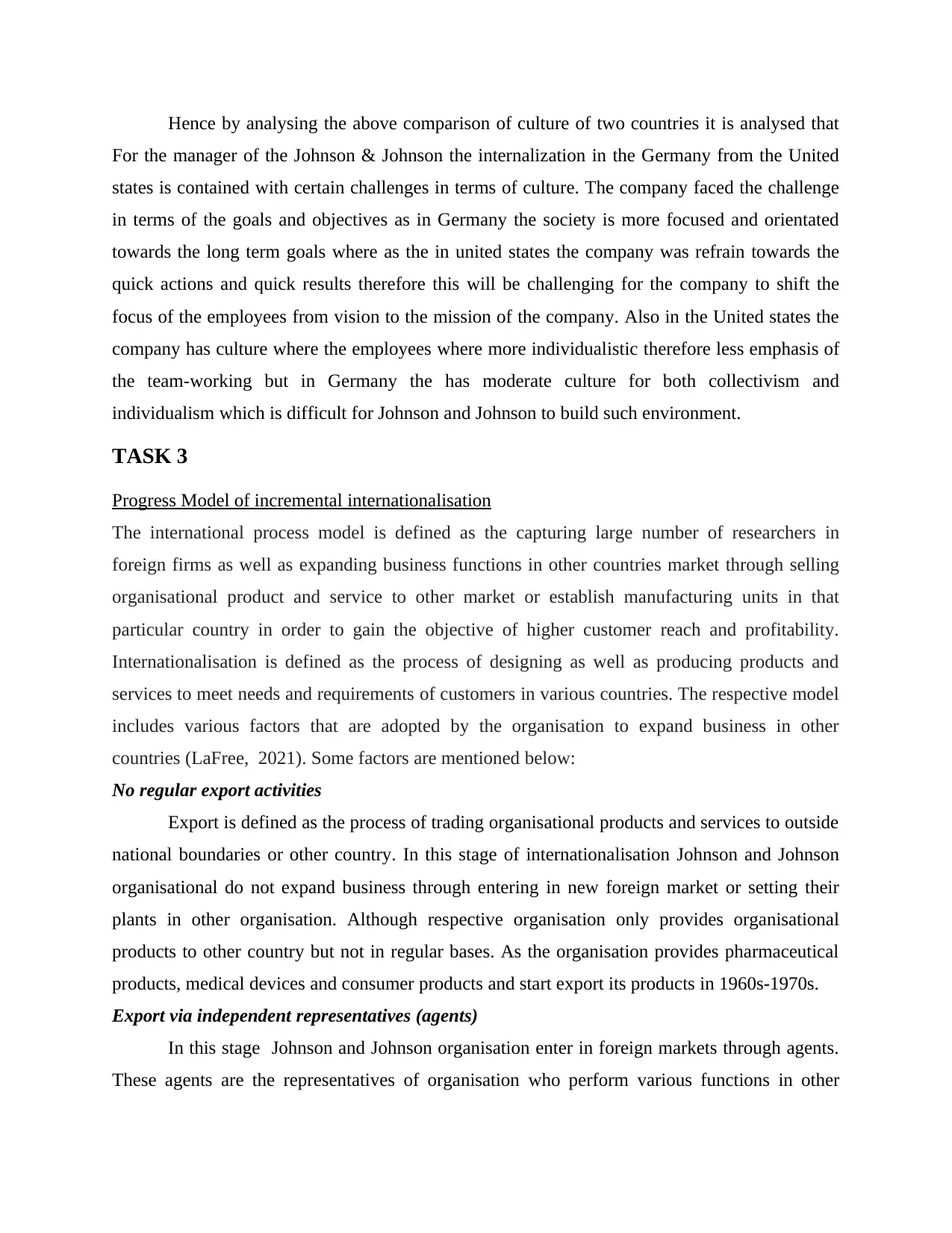
Hence by analysing the above comparison of culture of two countries it is analysed that
For the manager of the Johnson & Johnson the internalization in the Germany from the United
states is contained with certain challenges in terms of culture. The company faced the challenge
in terms of the goals and objectives as in Germany the society is more focused and orientated
towards the long term goals where as the in united states the company was refrain towards the
quick actions and quick results therefore this will be challenging for the company to shift the
focus of the employees from vision to the mission of the company. Also in the United states the
company has culture where the employees where more individualistic therefore less emphasis of
the team-working but in Germany the has moderate culture for both collectivism and
individualism which is difficult for Johnson and Johnson to build such environment.
TASK 3
Progress Model of incremental internationalisation
The international process model is defined as the capturing large number of researchers in
foreign firms as well as expanding business functions in other countries market through selling
organisational product and service to other market or establish manufacturing units in that
particular country in order to gain the objective of higher customer reach and profitability.
Internationalisation is defined as the process of designing as well as producing products and
services to meet needs and requirements of customers in various countries. The respective model
includes various factors that are adopted by the organisation to expand business in other
countries (LaFree, 2021). Some factors are mentioned below:
No regular export activities
Export is defined as the process of trading organisational products and services to outside
national boundaries or other country. In this stage of internationalisation Johnson and Johnson
organisational do not expand business through entering in new foreign market or setting their
plants in other organisation. Although respective organisation only provides organisational
products to other country but not in regular bases. As the organisation provides pharmaceutical
products, medical devices and consumer products and start export its products in 1960s-1970s.
Export via independent representatives (agents)
In this stage Johnson and Johnson organisation enter in foreign markets through agents.
These agents are the representatives of organisation who perform various functions in other
For the manager of the Johnson & Johnson the internalization in the Germany from the United
states is contained with certain challenges in terms of culture. The company faced the challenge
in terms of the goals and objectives as in Germany the society is more focused and orientated
towards the long term goals where as the in united states the company was refrain towards the
quick actions and quick results therefore this will be challenging for the company to shift the
focus of the employees from vision to the mission of the company. Also in the United states the
company has culture where the employees where more individualistic therefore less emphasis of
the team-working but in Germany the has moderate culture for both collectivism and
individualism which is difficult for Johnson and Johnson to build such environment.
TASK 3
Progress Model of incremental internationalisation
The international process model is defined as the capturing large number of researchers in
foreign firms as well as expanding business functions in other countries market through selling
organisational product and service to other market or establish manufacturing units in that
particular country in order to gain the objective of higher customer reach and profitability.
Internationalisation is defined as the process of designing as well as producing products and
services to meet needs and requirements of customers in various countries. The respective model
includes various factors that are adopted by the organisation to expand business in other
countries (LaFree, 2021). Some factors are mentioned below:
No regular export activities
Export is defined as the process of trading organisational products and services to outside
national boundaries or other country. In this stage of internationalisation Johnson and Johnson
organisational do not expand business through entering in new foreign market or setting their
plants in other organisation. Although respective organisation only provides organisational
products to other country but not in regular bases. As the organisation provides pharmaceutical
products, medical devices and consumer products and start export its products in 1960s-1970s.
Export via independent representatives (agents)
In this stage Johnson and Johnson organisation enter in foreign markets through agents.
These agents are the representatives of organisation who perform various functions in other
Secure Best Marks with AI Grader
Need help grading? Try our AI Grader for instant feedback on your assignments.
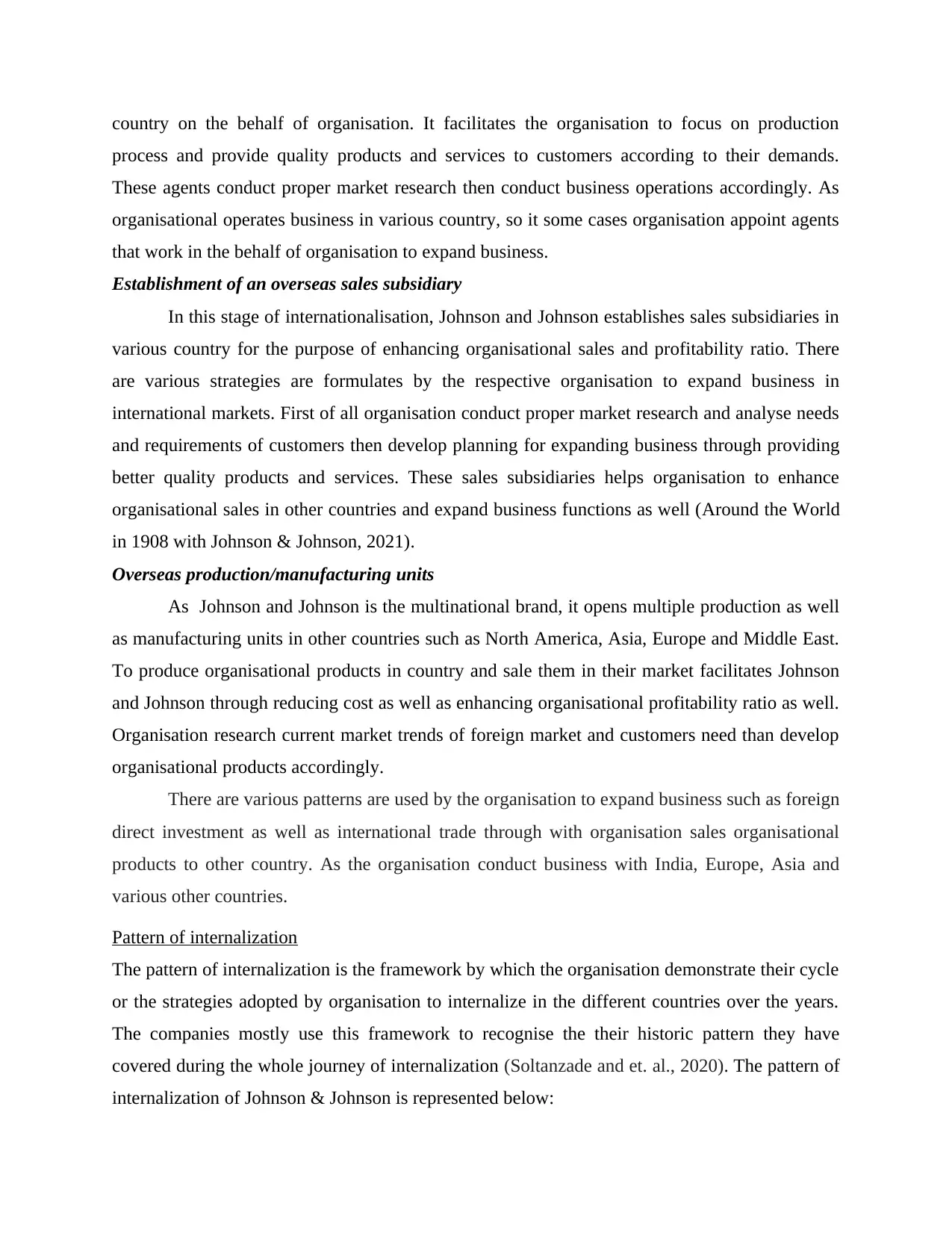
country on the behalf of organisation. It facilitates the organisation to focus on production
process and provide quality products and services to customers according to their demands.
These agents conduct proper market research then conduct business operations accordingly. As
organisational operates business in various country, so it some cases organisation appoint agents
that work in the behalf of organisation to expand business.
Establishment of an overseas sales subsidiary
In this stage of internationalisation, Johnson and Johnson establishes sales subsidiaries in
various country for the purpose of enhancing organisational sales and profitability ratio. There
are various strategies are formulates by the respective organisation to expand business in
international markets. First of all organisation conduct proper market research and analyse needs
and requirements of customers then develop planning for expanding business through providing
better quality products and services. These sales subsidiaries helps organisation to enhance
organisational sales in other countries and expand business functions as well (Around the World
in 1908 with Johnson & Johnson, 2021).
Overseas production/manufacturing units
As Johnson and Johnson is the multinational brand, it opens multiple production as well
as manufacturing units in other countries such as North America, Asia, Europe and Middle East.
To produce organisational products in country and sale them in their market facilitates Johnson
and Johnson through reducing cost as well as enhancing organisational profitability ratio as well.
Organisation research current market trends of foreign market and customers need than develop
organisational products accordingly.
There are various patterns are used by the organisation to expand business such as foreign
direct investment as well as international trade through with organisation sales organisational
products to other country. As the organisation conduct business with India, Europe, Asia and
various other countries.
Pattern of internalization
The pattern of internalization is the framework by which the organisation demonstrate their cycle
or the strategies adopted by organisation to internalize in the different countries over the years.
The companies mostly use this framework to recognise the their historic pattern they have
covered during the whole journey of internalization (Soltanzade and et. al., 2020). The pattern of
internalization of Johnson & Johnson is represented below:
process and provide quality products and services to customers according to their demands.
These agents conduct proper market research then conduct business operations accordingly. As
organisational operates business in various country, so it some cases organisation appoint agents
that work in the behalf of organisation to expand business.
Establishment of an overseas sales subsidiary
In this stage of internationalisation, Johnson and Johnson establishes sales subsidiaries in
various country for the purpose of enhancing organisational sales and profitability ratio. There
are various strategies are formulates by the respective organisation to expand business in
international markets. First of all organisation conduct proper market research and analyse needs
and requirements of customers then develop planning for expanding business through providing
better quality products and services. These sales subsidiaries helps organisation to enhance
organisational sales in other countries and expand business functions as well (Around the World
in 1908 with Johnson & Johnson, 2021).
Overseas production/manufacturing units
As Johnson and Johnson is the multinational brand, it opens multiple production as well
as manufacturing units in other countries such as North America, Asia, Europe and Middle East.
To produce organisational products in country and sale them in their market facilitates Johnson
and Johnson through reducing cost as well as enhancing organisational profitability ratio as well.
Organisation research current market trends of foreign market and customers need than develop
organisational products accordingly.
There are various patterns are used by the organisation to expand business such as foreign
direct investment as well as international trade through with organisation sales organisational
products to other country. As the organisation conduct business with India, Europe, Asia and
various other countries.
Pattern of internalization
The pattern of internalization is the framework by which the organisation demonstrate their cycle
or the strategies adopted by organisation to internalize in the different countries over the years.
The companies mostly use this framework to recognise the their historic pattern they have
covered during the whole journey of internalization (Soltanzade and et. al., 2020). The pattern of
internalization of Johnson & Johnson is represented below:
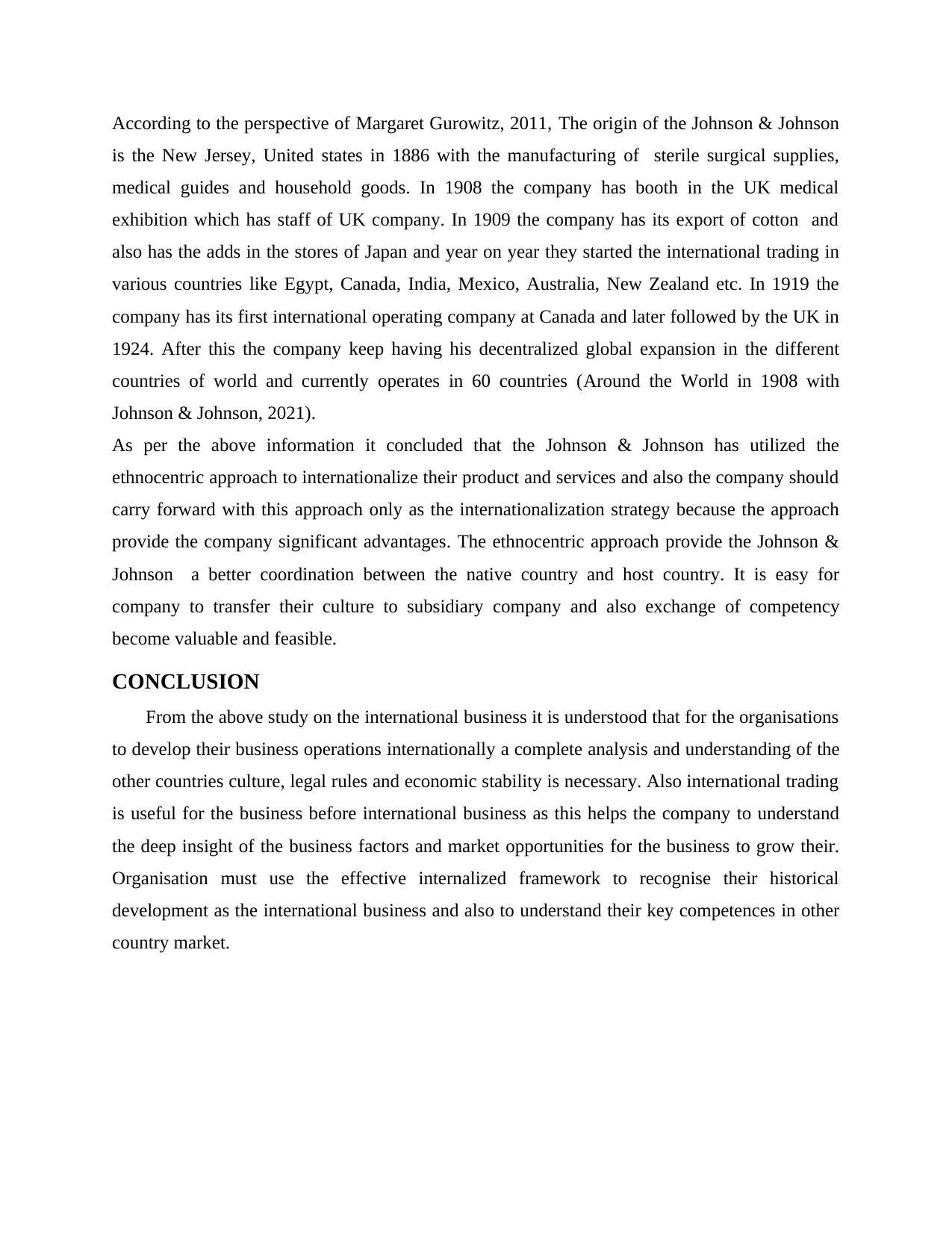
According to the perspective of Margaret Gurowitz, 2011, The origin of the Johnson & Johnson
is the New Jersey, United states in 1886 with the manufacturing of sterile surgical supplies,
medical guides and household goods. In 1908 the company has booth in the UK medical
exhibition which has staff of UK company. In 1909 the company has its export of cotton and
also has the adds in the stores of Japan and year on year they started the international trading in
various countries like Egypt, Canada, India, Mexico, Australia, New Zealand etc. In 1919 the
company has its first international operating company at Canada and later followed by the UK in
1924. After this the company keep having his decentralized global expansion in the different
countries of world and currently operates in 60 countries (Around the World in 1908 with
Johnson & Johnson, 2021).
As per the above information it concluded that the Johnson & Johnson has utilized the
ethnocentric approach to internationalize their product and services and also the company should
carry forward with this approach only as the internationalization strategy because the approach
provide the company significant advantages. The ethnocentric approach provide the Johnson &
Johnson a better coordination between the native country and host country. It is easy for
company to transfer their culture to subsidiary company and also exchange of competency
become valuable and feasible.
CONCLUSION
From the above study on the international business it is understood that for the organisations
to develop their business operations internationally a complete analysis and understanding of the
other countries culture, legal rules and economic stability is necessary. Also international trading
is useful for the business before international business as this helps the company to understand
the deep insight of the business factors and market opportunities for the business to grow their.
Organisation must use the effective internalized framework to recognise their historical
development as the international business and also to understand their key competences in other
country market.
is the New Jersey, United states in 1886 with the manufacturing of sterile surgical supplies,
medical guides and household goods. In 1908 the company has booth in the UK medical
exhibition which has staff of UK company. In 1909 the company has its export of cotton and
also has the adds in the stores of Japan and year on year they started the international trading in
various countries like Egypt, Canada, India, Mexico, Australia, New Zealand etc. In 1919 the
company has its first international operating company at Canada and later followed by the UK in
1924. After this the company keep having his decentralized global expansion in the different
countries of world and currently operates in 60 countries (Around the World in 1908 with
Johnson & Johnson, 2021).
As per the above information it concluded that the Johnson & Johnson has utilized the
ethnocentric approach to internationalize their product and services and also the company should
carry forward with this approach only as the internationalization strategy because the approach
provide the company significant advantages. The ethnocentric approach provide the Johnson &
Johnson a better coordination between the native country and host country. It is easy for
company to transfer their culture to subsidiary company and also exchange of competency
become valuable and feasible.
CONCLUSION
From the above study on the international business it is understood that for the organisations
to develop their business operations internationally a complete analysis and understanding of the
other countries culture, legal rules and economic stability is necessary. Also international trading
is useful for the business before international business as this helps the company to understand
the deep insight of the business factors and market opportunities for the business to grow their.
Organisation must use the effective internalized framework to recognise their historical
development as the international business and also to understand their key competences in other
country market.
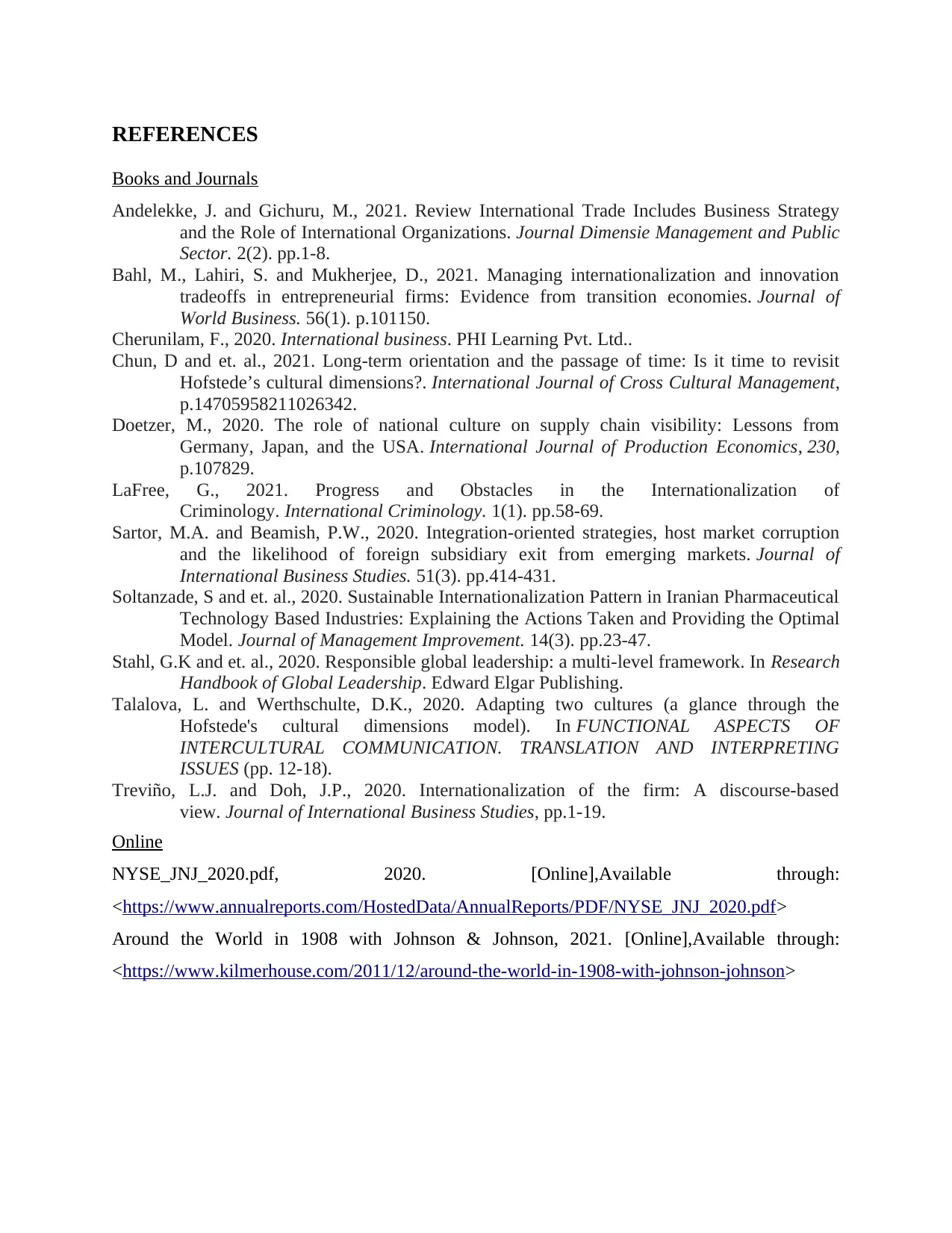
REFERENCES
Books and Journals
Andelekke, J. and Gichuru, M., 2021. Review International Trade Includes Business Strategy
and the Role of International Organizations. Journal Dimensie Management and Public
Sector. 2(2). pp.1-8.
Bahl, M., Lahiri, S. and Mukherjee, D., 2021. Managing internationalization and innovation
tradeoffs in entrepreneurial firms: Evidence from transition economies. Journal of
World Business. 56(1). p.101150.
Cherunilam, F., 2020. International business. PHI Learning Pvt. Ltd..
Chun, D and et. al., 2021. Long-term orientation and the passage of time: Is it time to revisit
Hofstede’s cultural dimensions?. International Journal of Cross Cultural Management,
p.14705958211026342.
Doetzer, M., 2020. The role of national culture on supply chain visibility: Lessons from
Germany, Japan, and the USA. International Journal of Production Economics, 230,
p.107829.
LaFree, G., 2021. Progress and Obstacles in the Internationalization of
Criminology. International Criminology. 1(1). pp.58-69.
Sartor, M.A. and Beamish, P.W., 2020. Integration-oriented strategies, host market corruption
and the likelihood of foreign subsidiary exit from emerging markets. Journal of
International Business Studies. 51(3). pp.414-431.
Soltanzade, S and et. al., 2020. Sustainable Internationalization Pattern in Iranian Pharmaceutical
Technology Based Industries: Explaining the Actions Taken and Providing the Optimal
Model. Journal of Management Improvement. 14(3). pp.23-47.
Stahl, G.K and et. al., 2020. Responsible global leadership: a multi-level framework. In Research
Handbook of Global Leadership. Edward Elgar Publishing.
Talalova, L. and Werthschulte, D.K., 2020. Adapting two cultures (a glance through the
Hofstede's cultural dimensions model). In FUNCTIONAL ASPECTS OF
INTERCULTURAL COMMUNICATION. TRANSLATION AND INTERPRETING
ISSUES (pp. 12-18).
Treviño, L.J. and Doh, J.P., 2020. Internationalization of the firm: A discourse-based
view. Journal of International Business Studies, pp.1-19.
Online
NYSE_JNJ_2020.pdf, 2020. [Online],Available through:
<https://www.annualreports.com/HostedData/AnnualReports/PDF/NYSE_JNJ_2020.pdf>
Around the World in 1908 with Johnson & Johnson, 2021. [Online],Available through:
<https://www.kilmerhouse.com/2011/12/around-the-world-in-1908-with-johnson-johnson>
Books and Journals
Andelekke, J. and Gichuru, M., 2021. Review International Trade Includes Business Strategy
and the Role of International Organizations. Journal Dimensie Management and Public
Sector. 2(2). pp.1-8.
Bahl, M., Lahiri, S. and Mukherjee, D., 2021. Managing internationalization and innovation
tradeoffs in entrepreneurial firms: Evidence from transition economies. Journal of
World Business. 56(1). p.101150.
Cherunilam, F., 2020. International business. PHI Learning Pvt. Ltd..
Chun, D and et. al., 2021. Long-term orientation and the passage of time: Is it time to revisit
Hofstede’s cultural dimensions?. International Journal of Cross Cultural Management,
p.14705958211026342.
Doetzer, M., 2020. The role of national culture on supply chain visibility: Lessons from
Germany, Japan, and the USA. International Journal of Production Economics, 230,
p.107829.
LaFree, G., 2021. Progress and Obstacles in the Internationalization of
Criminology. International Criminology. 1(1). pp.58-69.
Sartor, M.A. and Beamish, P.W., 2020. Integration-oriented strategies, host market corruption
and the likelihood of foreign subsidiary exit from emerging markets. Journal of
International Business Studies. 51(3). pp.414-431.
Soltanzade, S and et. al., 2020. Sustainable Internationalization Pattern in Iranian Pharmaceutical
Technology Based Industries: Explaining the Actions Taken and Providing the Optimal
Model. Journal of Management Improvement. 14(3). pp.23-47.
Stahl, G.K and et. al., 2020. Responsible global leadership: a multi-level framework. In Research
Handbook of Global Leadership. Edward Elgar Publishing.
Talalova, L. and Werthschulte, D.K., 2020. Adapting two cultures (a glance through the
Hofstede's cultural dimensions model). In FUNCTIONAL ASPECTS OF
INTERCULTURAL COMMUNICATION. TRANSLATION AND INTERPRETING
ISSUES (pp. 12-18).
Treviño, L.J. and Doh, J.P., 2020. Internationalization of the firm: A discourse-based
view. Journal of International Business Studies, pp.1-19.
Online
NYSE_JNJ_2020.pdf, 2020. [Online],Available through:
<https://www.annualreports.com/HostedData/AnnualReports/PDF/NYSE_JNJ_2020.pdf>
Around the World in 1908 with Johnson & Johnson, 2021. [Online],Available through:
<https://www.kilmerhouse.com/2011/12/around-the-world-in-1908-with-johnson-johnson>
1 out of 13
Related Documents
Your All-in-One AI-Powered Toolkit for Academic Success.
+13062052269
info@desklib.com
Available 24*7 on WhatsApp / Email
![[object Object]](/_next/static/media/star-bottom.7253800d.svg)
Unlock your academic potential
© 2024 | Zucol Services PVT LTD | All rights reserved.





